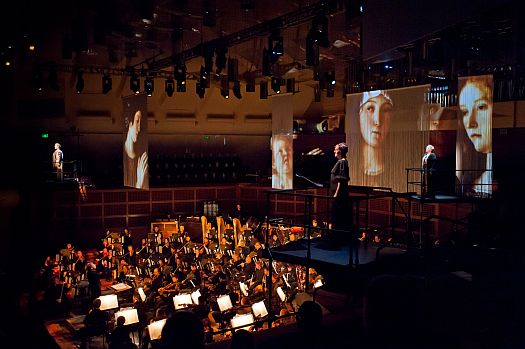 United States Debussy, Janáček: Karina Gauvin (soprano), Joanna Taber (soprano), Sasha Cooke (mezzo-soprano), Leah Wool (mezzo-soprano), Frederica von Stade (narrator), San Francisco Symphony Chorus, San Francisco Symphony, Michael Tilson Thomas (conductor), Davies Symphony Hall, San Francisco, 13.1.2012 (HS)
United States Debussy, Janáček: Karina Gauvin (soprano), Joanna Taber (soprano), Sasha Cooke (mezzo-soprano), Leah Wool (mezzo-soprano), Frederica von Stade (narrator), San Francisco Symphony Chorus, San Francisco Symphony, Michael Tilson Thomas (conductor), Davies Symphony Hall, San Francisco, 13.1.2012 (HS)
Janáček: Sinfonietta
Debussy: The Martyrdom of Saint Sébastian

Additional credits: Anne Patterson (director and designer), Matthew Frey (lighting designer), Adam Larsen (projection designer), projected performances by San Francisco Ballet, principal dancer Damian Smith, choreographed by Myles Thatcher
Taken on its own, as 60 minutes of gorgeously crafted music by the most widely performed French Impressionist composer, Debussy’s The Martyrdom of Saint Sebastian presents enough transcendently beautiful moments to make the San Francisco Symphony’s mounting of a multimedia extravaganza around it very much worth the trouble. Rather than focus on a suite Debussy later put together, conductor Michael Tilson Thomas elected to play all the music that Debussy wrote for a 1911 multimedia show of its time, a five-hour affair with actors performing the overheated poetry of Gabriele d’Annunzio, with dance by Ida Rubinstein and Bronislava Nikinska of the Ballets Russes.
The full title, Le Martyre de Saint Sébastien, a Mystery Composed in French Rhythm by Gabriele d’Annunzio, provides some sense of the grandeur the original creators strove to achieve. A century later, designer Anne Patterson dropped white beaded curtains above the orchestra, upon which video projections by Adam Larsen included scenes of San Francisco Ballet’s principal dancer, a near-naked Damian Smith, to writhe along with the music. (Over the centuries, homoeroticism is a recurring element in depictions of Saint Sébastian, usually seen naked and pierced by more than a dozen arrows.)
Several platforms jutted out from the chorus tiers curving behind the orchestra as perches for four all-female singers and narrator Frederica von Stade, who wielded her idiomatic French and theatrical instincts to bring real gravitas to her scenes. to just enough of the text to set the scenes for which Debussy provided music. The composer wrote the piece in three feverish months, after putting off the assignment for almost a year. His hesitance is understandable. Debussy’s sense of taste and poise clearly clashed with d’Annunzio’s often kitschy poetry. Channeling his inner Wagner, Debussy understandably aimed for something more overtly emotional than he did in his opera Pelléas and Mélisande. The score teems with arresting details and a finish that can only be described as divine.
The delicate opening section, “The Court of the Lilies,” sets the scene with intricate murmurings in the orchestra and a ravishing duet in parallel thirds for two mezzo-sopranos, delivered with purity by Sasha Cooke and Leah Wool. The orchestra was mesmerizing in the time-stopping opening for the next section, “The Magic Chamber,” a sinuous contrabassoon solo weaving against shimmering strings. Soprano Karina Gauvin added a silvery, creamy sound to the mix. An English horn solo that will put any opera lover in mind of the opening of Act III of Wagner’s Tristan und Isolde begins the fourth section, “The Broken Laurel,” beautifully played by principal Ross deLuna.
The finale, which found the chorus reaching ecstatically for high harmonies, stops short of the fervency that another French composer, Olivier Messiaen, was famous for. Debussy hewed to a rigorous set of musical values, and those were in evidence, providing material for a colorful and sensitive orchestral performance and sensuous vocal work by all involved.
In the evening curtain-raiser, Leoš Janáček’s Sinfonietta, the orchestra had its chance to let loose, especially the brass section augmented by nine extra trumpets. Tilson Thomas conducted the episodic music with a sustained sense of inevitability. The opening brass fanfares built organically and gradually, and their return at the end, accompanied by the full orchestra, closed a loop rather than coming out of nowhere.
Harvey Steiman